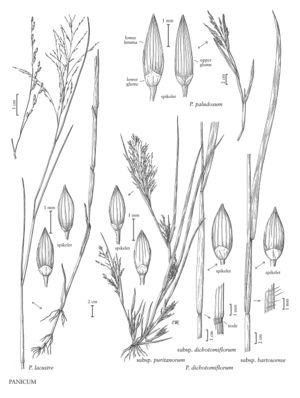Panicum lacustre
Plants perennial; emergent aquatic or terrestrial, rooting at the lower nodes. Culms 100-150 cm, erect, succulent, with short innovations; nodes glabrous; internodes glabrous. Sheaths compressed, not keeled, overlapping but narrow, exposing the nodes, bladeless and glabrous or sparsely pilose below the water; ligules 1-2 mm, membranous, ciliate; blades 1-30 cm long, 2-4 mm wide, narrow, linear, flat or folded, abaxial surfaces sparsely pubescent, adaxial surfaces sparsely pilose. Panicles 10-30 cm, open, with many spikelets; primary branches fascicled at the base of the panicles, solitary and distant distally; pedicels 1-4 mm, sharply 3-angled, appressed. Spikelets 2-2.2 mm, glabrous. Lower glumes truncate to broadly triangular, 1/4 as long as the spikelets, 3-veined; lower paleas absent; upper glumes and lower lemmas equal, slightly exceeding the upper florets, 5-veined or 7-veined, pointed; lower florets sterile; upper florets relatively thin, smooth. 2n = unknown.
Discussion
Panicum lacustre grows in shallow water or wet soil at the edge of cypress ponds in the Everglades of southern Florida. It also grows in Cuba.
Selected References
None.
Lower Taxa
"decumbent" is not a number."-11-veined" is not declared as a valid unit of measurement for this property."thin" is not a number.
